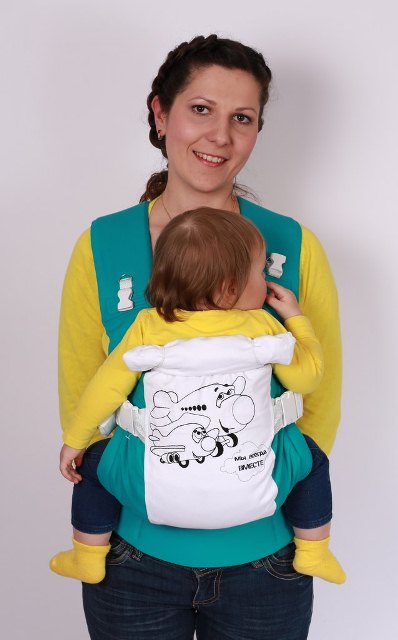An ergo backpack (aka ERGObaby, physiological backpack, ergonomic backpack, sling backpack) is a type of carrying children, which, due to its design features, allows you to place the child in the most correct, physiological position. Currently, it is considered one of the most comfortable and safe ways carrying children. Until, of course, they come up with something more convenient. 🙂
Who invented the Ergo backpack
In 2001, Hawaiian designer and young mother Caryn Frost began to experience difficulties maintaining the active lifestyle she loved so much. Solving this problem, she came up with the first ever backpack carrier. In consultation with her mother’s physiotherapist, Caryn sewed a backpack that was as comfortable as possible for both parent and child, taking into account all the characteristics of the baby’s body.
Her product attracted a lot of attention from other women, because everyone wanted to have such a convenient thing for carrying children. So the Ergo backpack “went viral”
Well, Karyn constantly improved her invention. The backpack was named ERGObaby, and mass production began in 2003. Now ergo backpacks are produced by various companies and are popular in almost 30 countries around the world.
How does an Ergo backpack differ from a kangaroo and a sling?
By way of putting on the ergo backpack is more reminiscent of a kangaroo, since, unlike slings, it does not need to be wound around itself, so no special skill is required. However, due to the tight belt located on the hips, the load is redistributed so that the shoulders and back are not so tired.
On the other hand, in an ergo backpack, unlike a kangaroo, there are no barriers between mother and baby, which makes feeding possible. Baby, of course. What did you think? 🙂
According to the child's location ergo backpacks, on the contrary, are more close to slings. If in a kangaroo the child often finds himself hanging on the crotch, then in this type of carrying the baby’s position is more physiological.
When the child is seated correctly, his legs are symmetrically apart and his butt is below his knees. The location of the buttocks and legs resembles a clearly defined letter “M”.
Newborn insert in an ergo backpack, if it exists at all, is not physiological, unlike in a kangaroo. This is due to the fact that the backpack itself is not suitable for carrying children in the first months of life.
In essence, an ergo backpack is the optimal combination positive characteristics sling and kangaroo.
It is easy to put on and comfortable to wear, and is as safe as possible for the health of the child and mother.
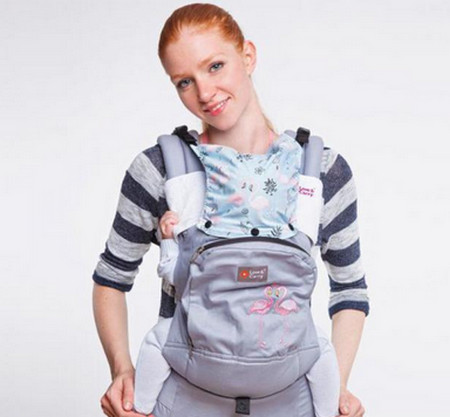
At what age can you carry a child in an ergo backpack?
We have already discussed. How is an ergo backpack different in this sense?
When determining the age at which you can carry a baby in an ergo backpack, you should be guided not by the number of months lived, but by the development of the following skills:
- holds his head well;
- rests independently on the forearms.
In addition, you need to take into account the child’s parameters:
- height from 65 cm;
- weight from 7.5 kg.
This usually corresponds to the age of 4 months, which is why it is often said that You can carry a baby in an ergo backpack from 4 months. But we should not forget that all children develop in their own way, some may be ahead of development standards, others may lag behind them. And all the criteria for the development of children, likewise, are quite conditional. Therefore, the listed characteristics play a role, and not the actual age of the child.
This will help determine if your baby is ready to be carried in an ergo backpack. simple test. You need to sit the child on a flat surface (without support). If the child sits and holds his head well, then you can use the ergo backpack.
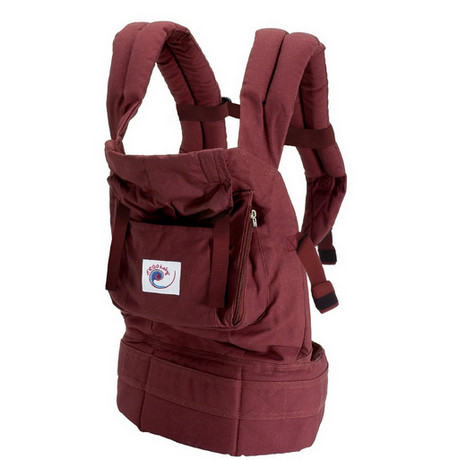
The optimal age when you can start carrying a child in an ergo backpack is considered to be the period when the child has already learned to sit independently. Then it can be carried in four positions:
- traditionally, belly to belly;
- belly to back, i.e. the ergo-backpack is located behind the mother’s back;
- on the thigh;
- facing away from mom. However, in pediatrics, the question of how safe it is for the baby’s psyche to be in this position is controversial.
How to choose the right ergo backpack
Choosing the right ergo backpack is not as easy as it might seem at first glance. The stores offer too wide an assortment, and the model recommended on some forum may not be suitable for your child at all. What should you pay attention to?
Firstly, the backpack must be the right size. Therefore, you need to try it on. The child must position himself in it so that there are no empty spaces left, otherwise the physiological fit will not be ensured. You should refrain from buying one for growth if you plan to immediately start carrying your son or daughter in it. Backpacks labeled as universal have a non-adjustable back, so adjust it to suit your needs. individual characteristics your child will be problematic.
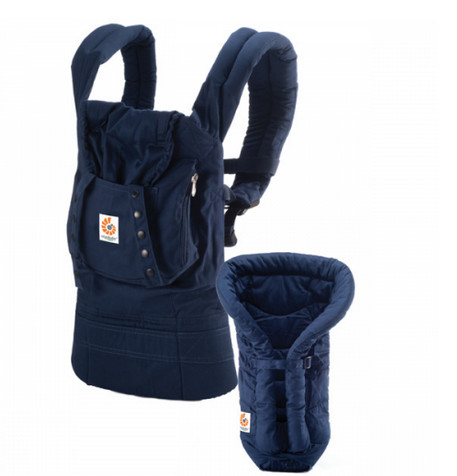
The baby should sit tightly and evenly, the neck should not dangle, it, like the spine itself, needs good support, the legs should be spread symmetrically, and resemble the letter “M”, not “P”.
Secondly, you need to determine the width of the back of the backpack, as well as the possibility of its adjustment. But you can’t loosen or tighten the lines too much. The child's back should resemble a slight arc, and not be straight or a wheel. The baby's knees should be outside, not inside, the back of the backpack.
Thirdly, the straps should be soft and dense, and the belt should be rigid and wide. The load must be distributed correctly, otherwise mom’s (or dad’s? :)) lower back and shoulders will suffer. The fabric must be natural.
It must be remembered that an ergo backpack is a method of carrying with specified parameters. Therefore, if the child grows out of it, you will have to buy a new one.
How to put on an ergo backpack yourself
The ergo backpack is easy to put on yourself. Problems may arise only if you want to independently place the child in a position behind your back. In other cases, no particular difficulties should arise.
First you need to put on a backpack and snap the carabiners on your hips.
Then take the child, hold him close to you with one hand, and with the other, place the fabric of the backpack under his buttocks and gently pull the child up, not forgetting to support him under the butt with the fabric.
When putting on an ergo backpack, remember that the child needs to be dressed much lighter than when walking with a stroller.
This is especially true on hot days. In the backpack the child is already warm from the mother’s body. Likewise, the woman herself will feel hot from the proximity of the baby. The child's trousers should be made of pleasant, soft fabric.
Clothing should not cause discomfort. By the way, your trouser legs will constantly ride up, and if it’s not hot outside, you should take care that your legs are not exposed.
Well, what do you think is better to use for carrying newborns - an ergo backpack or a kangaroo?
You have already read a lot about (slingo backpacks) and decided to try it for your baby. But very often, mothers who are planning to buy such a carrier for a child and have rented it to try or have already bought it, have a question, and some even fear, how to properly put on an ergo-backpack so that the position of your child is correct. It is especially important to provide constant back support to children who are not yet sitting.
What you need to consider so that your first trip is pleasant and does not harm your child.
First, pay attention to his mood, it is important that he is not hungry and nothing bothers him.
Secondly, it matters where your baby will be. Clothes must be stretchy, allowing you to spread your legs freely. It is better to use clothes that do not have closed legs. Pants, leggings, and overalls with open legs at the bottom work well.
The sequence of putting on the ergo-backpack:
If you are putting it on for the first time, it will be better if you have an assistant next to you. You will feel more confident and your baby will be in a better mood.
1) Take an ergo-backpack (without a child). First, we put the belt around ourselves and fasten it. Before fastening, do not forget to thread the fastex (plastic fastener) through the protective elastic band. It protects your baby from unfastening the fastex. Even if the latch comes loose, the protective elastic band will hold it in place. Please note that it is better to place the belt not on the waist, but on the hips. It will be easier for you to wear your little miracle on your hips.
2) The belt is on, the back is hanging in front of you. Now we take the baby facing us. To make it more convenient to take the correct position, tilt the child slightly away from you and let him hug you with his legs in this position (slightly bent at the knees in the frog pose). Now we support the baby with one hand, and with the other we put on the strap of the ergo-backpack. Next, change the hand and put on the second strap. Now the straps are on, the child hugs you with his legs.
3) Now the most important thing is to fasten the strap on the back connecting the straps of the ergo-backpack. You can do this either with your hands on top or below, or with one hand on top and the other on the bottom.
4) Once you have fastened it on the back, you can check the position of your favorite angel and adjust if necessary. Check the waistband on your hips. The child hugs you with his knees, his butt is slightly below his knees. The knees and butt form the letter M. If you have a flattened M, that is, the angle of separation is greater, then without bending your knees behind the baby’s shins, lift your legs, lowering your butt. Adjust the straps of the ergo-backpack straps to pull your child closer or looser.
Pay attention to the support of the baby's back and neck. Do not tighten the straps too much to pull the child tightly. The spine should form a natural arch.
5) And finally put on, don’t stand still, move. The factor of motion sickness and learning about the world plays a role here. Babywearing beads for mom will also help you, they will make the trip interesting, enjoyable, and fun.
Every mother has ever faced the question of how to carry a baby. Many devices have been invented for this purpose, among which it is difficult to determine what is best for the child and what is most convenient for the mother. However, in recent years, slings and ergo-backpacks have become very popular. Although these devices are similar in some ways, they are still significantly different. In this article we will talk about the differences, and also try to answer the question of what better sling or ergo-backpack.
It should be noted that the main thing for the baby is to be in a position that does not contradict his physiology. If the spine of an adult is s-shaped, then the spine of an infant is c-shaped. This is because the baby is still in the fetal position most of the time. Only over time, curves form on his spine, which will allow him to hold his back, neck and head well. Until this happens, it is important for the baby to create conditions under which his C-shaped spine would not be disturbed. It’s worth writing right away that rigid kangaroos and “slings on boards” cannot cope with this function at all. They are simply harmful to the baby. Therefore, it is worth buying only high-quality slings and ergo-backpacks.
Photo from the site: detivmaline.ru
What is a baby sling
Let's first determine what a sling looks like and what it is. Then we will characterize it. A sling is a device for carrying babies made of fabric. There are several options for such a product, but all of them are united by the fact that the baby feels free in them and at the same time can be tightly pressed to the mother. The first is important for normal development bones and muscles of the child, the second - for his mental development.
Why do you need a sling? The benefits of carrying a baby in it can be summed up in a short list. This:
- comfortable position of the child;
- the wide arrangement of his hip joints;
- the opportunity to be very close to your mother and as much time as possible;
- almost imperceptible feeding at a convenient time.
It is comfortable for the baby to be in the sling. Nothing is constricting him, the pose is natural, neither horizontal nor vertical. This allows the baby's spine to form correctly.
When worn in this way, the baby’s hip joints are positioned wide, just as with “wide swaddling.” This also helps ensure proper bone development and avoid future foot problems.
In a sling, a mother can carry her baby with her anywhere. This way, the baby is not left at home alone. He feels affection for his mother, which has a positive effect on his psychological state. Children who spend a lot of time snuggled close to their mother grow up mentally stable and are less susceptible to stress. This is another point that explains why a sling is needed.
Breastfeeding in a sling is almost invisible. That is why with this device it is convenient to travel or even just go for some urgent business.
Slings on “boards” do not have these advantages. They do not allow the baby to be in a physiological position for him.
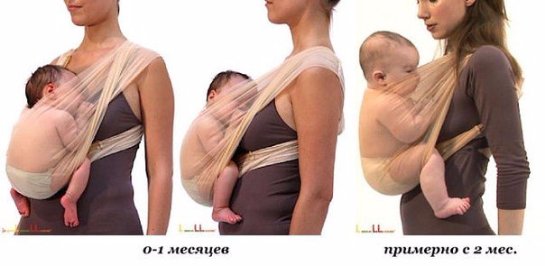
Photo from the site: www.guslenok.ru
Babywearing also offers benefits for mom. Among other things, a woman receives:
- free hands;
- the opportunity to lead an active lifestyle;
- the opportunity to be close to your child.
When the baby is in a sling, the mother's hands remain free. This allows a woman to do some work and carry the baby at the same time. This is an incredible advantage. In addition, a woman can go with her baby wherever she needs without additional inconvenience. She won't need to drag a large stroller on public transport. In addition, she will not get as tired as if she were simply carrying the baby in her arms. Thanks to its structure, the sling helps to redistribute the child’s weight so that there is no strain on the shoulders and back of an adult. Yes, of course, if you carry a baby all day, you will still get tired, but your strength will begin to leave you much later than if you walked with a regular kangaroo or simply carried the baby in your arms in the usual way.
What is a May Sling? This is the simplest type of this device, which has been used for a long time. This sling is easy to tie. Outwardly, it looks a little like a fart. Its straps cross on the back of the mother and the child. The advantage of this is its simplicity. Plus, you'll know the straps won't come undone as can happen with clasps.
The disadvantage of this type of sling is that its straps are simply very long. You may have to tie them twice. IN public place It will be difficult for you to bandage all this; the ends may touch the ground. If this bothers you, you can use a fast sling. It is secured with plastic fasteners. Its straps are shorter, so they definitely won’t reach the ground. At the same time, there will always be a risk that the plastic fasteners will unfasten spontaneously. You will have to constantly monitor this.
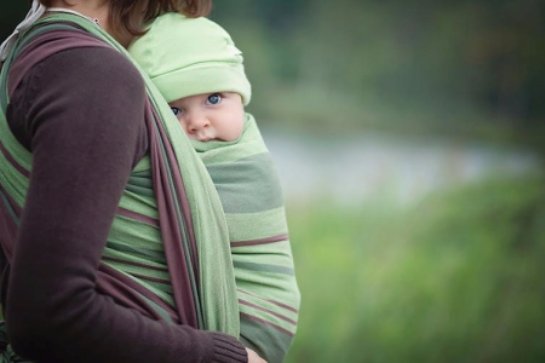
Sling: what is it, photo from the site: pozdnyakova.org
So, what is a sling for newborns is clear. But in order to determine whether a sling or an ergo-backpack is more convenient, it is important to identify what the second device is and what features it has.
Features of the ergo-backpack
The ergo backpack is made of soft materials. At the same time, it secures the child well in the arms of an adult. The position in which the baby is in the ergo-backpack is as close as possible to the one recommended by orthopedists. In particular, the baby's legs are spread wide apart, while the butt is lowered below them. At the same time, the baby's back is pressed tightly against the adult. This is how the c-position of the child’s spine is ensured.
The ergo-backpack is also convenient for mom. He clings to his hips. It is this part of the body that bears the most load. This way, mom’s arms and shoulders don’t get tired or hurt. This is a huge advantage that a regular kangaroo cannot provide.
The ergo-backpack also frees up the mother's hands, which allows her to carry the baby and do some work at the same time.
Another advantage of the ergo-backpack is that it is very convenient to breastfeed a baby. If such a need arises in a public place, then the process can be hidden with a special hood, which is found on most models.
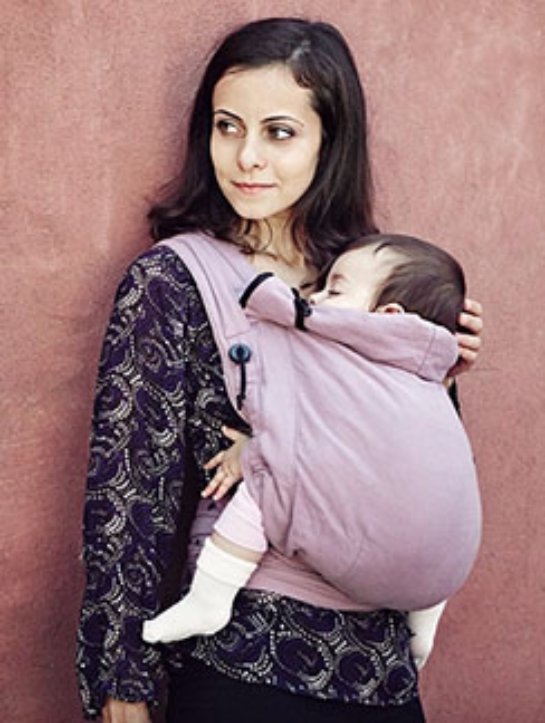
Photo from the site: Naturebaby.ru
What is the difference between an ergo-backpack and a kangaroo?
Do not confuse an ergo-backpack with a regular kangaroo. These products are completely different both in their convenience and safety for the child. How exactly are these products different?
- The first difference is that in an ergo-backpack the child’s legs are placed widely, while in a kangaroo they are placed narrowly. Thus, in the first case, the child’s legs are located comfortably, they do not hang down, since they are slightly higher than the butt. This pose is a prevention of hip dysplasia. In a kangaroo, the baby's legs hang down. This puts additional stress on the unformed children's spine. It turns out that kangaroo is not only not a preventive measure, but is also harmful.
- Another difference is in the belts. On the ergo-backpack they are wide and located in such a way that it is convenient to breastfeed the baby without reaching out. Also in this device there is always a belt. Together with the wide straps, it allows you to distribute the weight of the child in such a way that it is minimally difficult for the mother. In kangaroos, the straps are narrow, they dig into the body. In addition, in this option there is no belt, which means that the entire load goes on the shoulders of the woman who is carrying the baby. It will be difficult to feed a baby in a kangaroo, since there are belts between him and the mother.
- The ergo-backpack and the kangaroo have completely different backs. In the first case, it is soft, which allows you to pull the baby to the mother with straps as close as possible. In this position, the back of the baby is relaxed. But in a kangaroo the back is rigid. Even if the straps are tightened to the maximum, the baby may dangle inside the device. It simply won’t work to lean it tightly against mom, like in an ergo-backpack.
So which is better: sling or backpack? You will get the answer to this question in the next section.
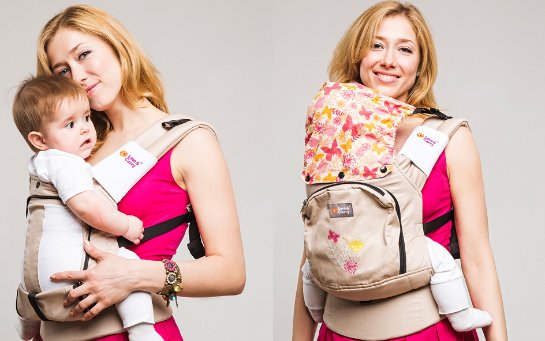
Photo from the site: mon-bebe.ru
Sling or kangaroo: which is better?
Having understood what each of the means is, we can draw conclusions, which is better: a sling or an ergo-backpack? It’s worth noting right away that many experts consider an ergo-backpack to be one of the types of slings that has the same advantages. However, these two devices for carrying children also have differences that some may consider advantages and others may consider disadvantages.
Everyone understands that the child is constantly growing, and with this his weight also increases. As the baby grows, the fabric of the sling can stretch greatly, which will make carrying the baby not entirely comfortable. This will not happen with an ergo backpack. The child will simply grow out of it over time.
An ergo backpack is convenient on the road or while staying in a public place. To get the baby out or put it back, you just need to unfasten it. The sling will have to be untied. Sometimes in this case you cannot do without outside help. This is, of course, a minus.
At the same time, the advantage of a sling is that it is suitable for every figure, that is, in fact, it is universal. Ergo backpacks still have their limits; they simply do not fit some female figures, since despite the adjustable straps they can be too large or small.
In addition, not all products are equally suitable for mothers. U different women special body parameters. This means that for some it is more convenient and easier to wear a sling, and for others an ergo backpack. To accurately determine the optimal product for yourself, try it on in the store. You can ask your girlfriends to try out a sling or backpack, or even buy previously used items first to save money. This way you can find something that is convenient for you.
You can also purchase several types of slings and ergo-backpacks at once and use them in turn as the child grows. For each baby’s weight, a certain product may be convenient.
On our website there are many different notes, videos, photographs on how to properly put on and adjust an ergonomic backpack.
But not every mother can understand what exactly needs to be paid attention to. In the video I say: “And we tighten the belt at the waist, placing it parallel to the floor,” but in reality, then photographs come in where the belt is worn differently. And such situations happen often. It’s just that many points are not given due attention, and this turns out to be important, because for some reason the back suddenly starts to hurt or the child is capricious. In fact, a novice sling mother may not even understand what she did wrong. She intuitively sees that her photo is somehow different from the photo from the site, but for the inexperienced eye this is not easy to do. To be honest, I also have dead-end situations when I don’t immediately understand what my mother’s mistake is.
In this article I will use photographs of our clients. I really hope that this will not cause a storm of emotions and resentment, because ultimately you have learned to do everything correctly. So let's help others learn from other people's mistakes and not step on the same "ergo rake" over and over again.
So let's start again with the belt. This is the first mistake , since the belt is put on first. We have a whole article about the belt, where it is written how to do everything correctly, " ", and now we will show you how not to do it and what it affects.
The belt is not located at the waist.
When the upper part of the belt is below the waist, the overall load distribution is disrupted. Main load in in this case falls on the shoulders and back. A belt worn low loses its functionality - the child’s weight does not fall on it, because in this case the child “hangs” above the belt. Our belt is quite wide, so it should fit the stomach and at the same time rest on the hips. In this case, the load on the lower back is very well removed.
Here is a photo with errors where the belt is worn low:
This also includes the following error:
The belt is fastened very loosely at the waist, so he slides forward and down under the weight of the child. Read again how to tighten the belt strap well. There are both videos and photos.
Why is this bad? Again, the load is unevenly distributed across the hips. Since the child is located in front, the gravity vector presses forward and down, and the maximum load is experienced by the upper point of support, namely the lower back and back as a whole. Hence the pain, discomfort, and rapid fatigue again.
And this includes the error when The belt initially seems to be put on tightly, but is skewed forward. The problem is the same with the center of gravity shifted downward and the load transferred to the lower back. So,
Stand sideways to the mirror and see if you have these mistakes? If not, let's move on =)
Second mistake mom - this is the wrong level of the child relative to the belt and relative to the mother’s chest.
Even if the belt is put on and fastened correctly, the child may sit low. In addition to the same problem with a displaced center of gravity, another problem appears - discomfort in the child.
In this photo, the backpack is worn at the correct height, the belt is well tightened and parallel to the floor. But something is still wrong.
What we see in the photo above. The belt is put on correctly, but the child is somehow flattened, there is no letter M, there is a feeling that the back is somehow flat, and the strangest thing is that for some reason the side fastex touches the child’s legs. In addition, the side shock absorbers are in a sluggish, untensioned position. This is a clear signal that there is an error.
And here’s the mistake. The back of the backpack is too far down relative to the level of the belt. The belt is not visible from behind the back during a frontal (in front of the mirror) examination. And what happens to the baby?
Instead of the baby’s pelvis and hips being located in the lower part of the back, which has a very convex, widened, embossed shape specifically for this purpose, they fall into the part that is located above and no longer has any darts or raised seams. The child's back should already be there. The child’s butt becomes flat, there is nowhere for it to fall, and a U-shaped position of the hips is formed (knees at the level of the butt - P).
And besides this, the fastex fasteners touch the child’s knees, which causes discomfort for both the baby and the mother. They are inconvenient to fasten and there is a risk of touching the child’s leg.
How to fix this?
In this case, you need to raise the child’s level so that the belt is clearly visible to you in the mirror. Ideally, when the belt is correctly placed around the waist, the child’s crotch is located opposite the mother’s navel. This must be done using the upper straps. Just grab them and pull them up, along with your child.
In the photo above, the belt is put on correctly and the child’s level relative to the belt is the most optimal. As you can see in the photo on the right, the butt is rounded, the M-position is perfectly tracked (knees above the butt - M), since in this part of the back there is a lot of space for the hips and pelvis. Side fastenings are located above the knees.
Third mistake - when we start adjusting the slings. Intuitively, we want to hold the child as close to us as possible so that he does not dangle in the backpack, lift him higher, and secure him tightly. The baby really needs to be pressed tightly against the mom so that mom and baby are like one. But this must be done correctly, without harming the child’s spine. And we begin to pull the line from the side - stronger and stronger...
And we get this picture:
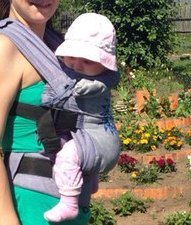 |
This should not be allowed under any circumstances. The child's back should have a natural rounded convex shape. The fabric should hug the back, support it, but not squeeze it. It’s like making a hammock out of fabric and lying in it. The fabric will be the support. But if you draw another strip of fabric (a rope of fabric) along the edges of this canvas, right under your shoulder blades, and begin to lift this fabric from both sides, you will feel unpleasant, and maybe even painful. At least this position cannot be called comfortable. And the child’s back still has a very weak muscle corset.
How to make sure that the back does not worry, how to lift the child higher, pull him closer to you. There is ours about this detailed video, and we post it on almost every page.. Because it is IMPORTANT.
In addition to the fact that the backrest is pinched and this in itself is already bad, this incorrect adjustment also causes other errors.
Due to the fact that the back is tightly tightened in the middle, there may be voids and bubbles from the fabric under the baby’s bottom. The child's weight is small, so this pinching simply keeps the child in a semi-suspended state. The child cannot fully sink into the lower part of the backrest, as the fabric holds him. And a frequent accompaniment of this mistake is the U-shaped position of the child’s butt and hips.
If you do everything correctly, as in the video, then the side of the back will look like this:
If you purchased a Universal design, then the zipper flap may not give a complete picture of how the baby’s back feels. You can tighten it, and since the valve itself does not create tension, you may not notice it.
A similar situation happens with another design of our backpack - There, in addition to the above-mentioned manipulations in the video for holding a child close to you, you need to pay attention special attention straps on the child's back. Since this design can begin to be mastered from 2-3 months of age due to other support for the child’s back, it is extremely important here, too, to use this backpack for good and not harm. After all, as you know, no matter what age a carrier is recommended (for example, a sling with rings and a sling-scarf are suitable from birth), if it is worn and adjusted incorrectly, it will do more harm than good. And then you can forget about the physiology of babywearing.
So, a similar error with the Comfort backpack.
To avoid such a mistake, the straps on the child’s back must be straightened as much as possible. They should not have folds. The bottom edges of the straps should extend slightly beyond the edge of the back. The higher the intersection point of these straps on the child’s back, the less pressure there will be on the spine, the better.
The photo above shows how wide the straps are on the baby's back. Their edges protrude beyond the back, and their upper intersection is raised quite high.
As you can see in these photos above, there is no backrest pinching. So,
Fourth mistake.
The child is not tightly pulled in the backpack; the fabric does not hug him along the entire height of the spine.
The photo above shows that the entire thoracic spine and shoulders of the child do not have proper support. there are a lot of empty spaces inside. Why isn't it safe?
Since the baby's back only rests on the lower part of the cloth, and the upper back and shoulders do not rest on the cloth, the baby is essentially sitting. This would not be so serious if the child already had independent sitting skills; his back muscles are ready for such loads, although, again, not for as long as what happens when walking in an ergo backpack.
If the child is not yet sitting, then this position is very dangerous. The entire load in this position falls on the lower part of the spine. Such a mistake may be due either to the fact that the carrier is still too large for the child in terms of volume and height (as in the case shown in the photo) and you just need to wait to use it, or you need to understand the reason why the child is not pulled in tightly. This is usually due to the fact that the baby has not sunk deeply into the back of the backpack (for one reason or another), and the upper straps of the backpack are not stretched enough.
It is very important to understand that the attraction should be maximum so that there are no voids between the back and the back of the child. Just taut fabric. As a check - you will not be able to put your hand between the child’s back and the fabric of the backpack.
In the photo above you can see that the fabric fits the child very tightly. No voids. This is right.
In the youngest children, up to 4 months, the issue of maximum traction of the shoulder girdle is especially relevant. That is why our vertical carriers for the little ones (may-sling, hybrid backpack, comfort backpack) provide an additional function of attracting the child’s shoulder girdle.
How does this happen? The shoulder straps of the carrier are twisted once on the “wrong” side, thereby creating additional tension exclusively in the child’s shoulder girdle. This is very important.
We intentionally put the word “wrong side” in quotation marks because on all of these carriers the inside of the straps have the same appearance and the same functional properties as on the outside.
Namely, on the inside of the strap there is exactly the same loop for fixing the headrest as on the outside. Therefore, you can also use the headrest when the strap is twisted.
Look at the photo above. They show how to turn the strap to inner side to better fit the child’s shoulder girdle.
* - Naturally, you need to understand that our carriers have such a function. You need to check if this function is available from other manufacturers.
Fifth mistake.
The child will feel uncomfortable if the back of the backpack is raised too high. This blocks his view, can rub his neck and the delicate skin of his cheeks and head, and this generally disrupts the correct fixation of his back, since a child in this position will intuitively push away from his mother, lift his head back, straighten his back and in every possible way interfere with maintaining the M-position.
How to fix the error? Very simple. Our backpacks have . To lower the back of an ergonomic backpack to the desired level, it is necessary.
For a child who still does not hold his head well (up to 3-4 months)
It is optimal if the height of the backrest is at the level of the child’s neck or slightly lower. Since the edge of the back is not softened in any way, it should not come into contact with the child’s head. To support your baby's fragile neck and head, it is better to use headrests specially designed for this purpose. There should be a SOFT ROLLER under the head of a child who still has trouble holding his head up. This is the most optimal device for carefully fixing the head, since it is voluminous and round, without seams and has no edges. And this soft round one and is fixed on the shoulder straps.
For a child who already holds his head well (from 4-5 months)
It is enough to keep the back at the level of the child’s shoulders. It is important that the child’s shoulder girdle is pulled in, and support for the head and neck is necessary when the child is sleeping, or if he throws his head back too much. In this case, you can also roll up a roll from the headrest for safety.
For a child over 6-7 months the backrest can be lowered to the level of the shoulder blades. Since at this age the child usually already knows how to sit independently,
It does not require support from the shoulder girdle, so you can lower the backrest and pull the handles out. Make sure that the fabric edge of the backrest does not cut into the child's armpits.
Sixth mistake.
Hollows in the lower back of the backpack. The child's butt is poorly sunken deep into the back. Sometimes there is a feeling of a P-position, the fabric of the back is not stretched.
This error occurs already when we carry a child with handles facing out .
There were cases when mothers successfully coped with the M-position for 2-3 months, with no pinching of the back, but when switching to carrying with the arms outward, difficulties began again. What is the essence of this error?
Here's the thing. When putting on an ergo backpack it is very important procedure . To maintain the correct M-position, provide maximum support for the child’s back and not overtighten the baby’s back when adjusting the straps, you must put on the backpack in the following order:
1. Pre-adjust the height of the backrest to the level of the child’s shoulder blades. We fix the slings and maintain this height if we plan to continue carrying the child this way. If we do not lower the back first, the child will be uncomfortable and he will be capricious.
2. when putting on the ergo backpack, we immediately give the child’s position the correct M-position, raise the back of the backpack and hold the child’s arms inside or just on the sides.
3. Carefully place the baby’s butt into the back of the ergo backpack, ensuring maximum attraction of the upper straps. There should be no voids in the fabric under the butt and back.
4. Fasten the fastex and tighten the slings, as described in the video on this page. Without pinching the back.
5. AND JUST NOW WE PULL THE CHILD'S HANDS OUT.
If you break this order and pull out the child’s arms to points 3 and 4, the child essentially will not be able to fall deep into the backrest. He will simply “hang” on the backrest, like a gymnast on the uneven bars, his lower back will be suspended. Visually this may not be noticeable, but in essence, the child can be held on his arms (armpits), while his hips, pelvis and lower back will not have proper support. This is easy to check - if the fabric is not stretched in the lower part of the backrest, if there is a feeling of the P-position, it means that the child has not sunk deep enough into the backrest. If the handles are on the outside, they must be removed inside and the above steps must be done in the correct order.
Perhaps these are not all the errors that we remembered. We identify many of them only thanks to your photos. We didn’t even know about many mistakes, and it’s very good that our clients’ photos help us figure them out and help other mothers not repeat these mistakes.
Happy and long babywearing to you.
Best regards, Olga Kovaleva
29 June 2013, 01:03
Attention! The post was written for those interested in proper wearing in ergos and slings! Moms who think that all this has no right to exist, don’t bother with empty comments, they will be deleted!
Look at the photo below
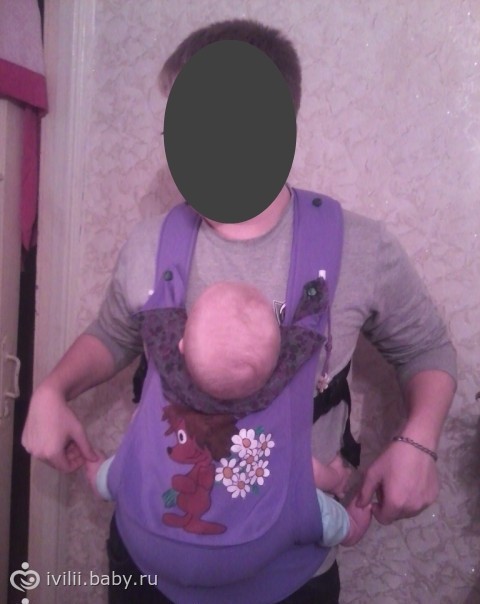
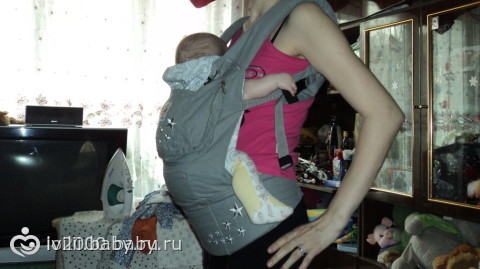
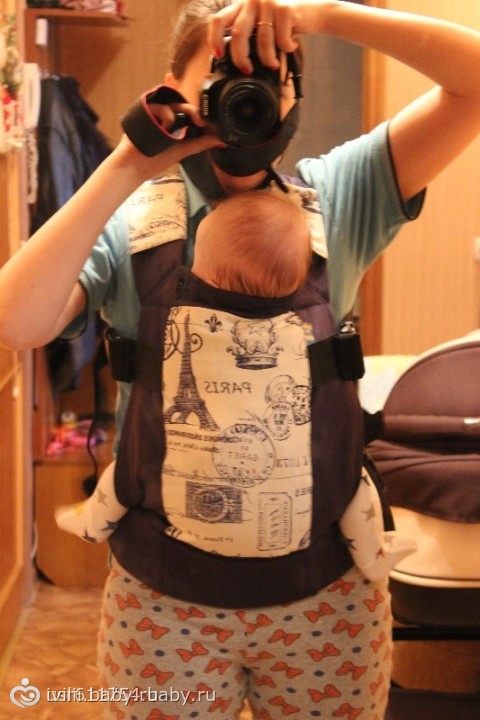
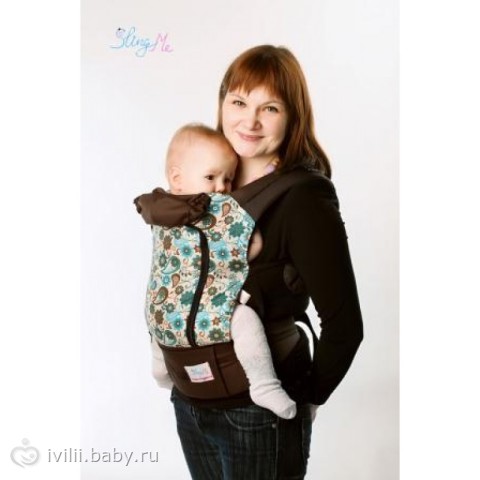
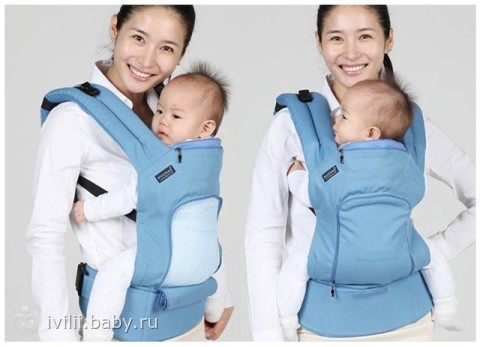
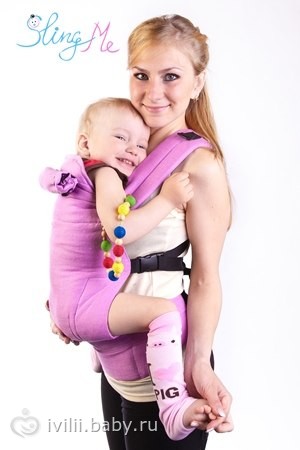
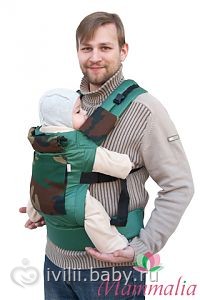
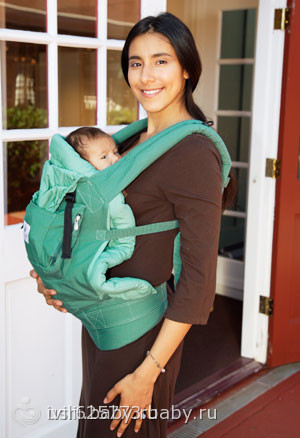
In all these photographs, children are positioned incorrectly in ergonomic backpacks; there is NO physiological position THERE.
Why? Maybe the backpacks are bad, of poor quality? No, backpacks are quite normal. Of course, some of them are more successful, some less so, but in all of these backpacks you CAN place the child in a safe and physiologically correct position.
So why do we see such a picture? Because you and I, parents, place the child in an ergonomic backpack. And this can very well be done incorrectly.
I constantly hear a similar phrase: “Take an ergo-backpack, everything is so simple, just fasten the fastex and go.”
This is not true. You have to KNOW how to use a backpack, you have to LEARN how to use a backpack. Otherwise, it is very likely that you will end up wearing it like in the photos above. I am sure that many will not even see where the mistakes are, but they are glaring and potentially affect the health of babies carried in this way.
Video instructions:
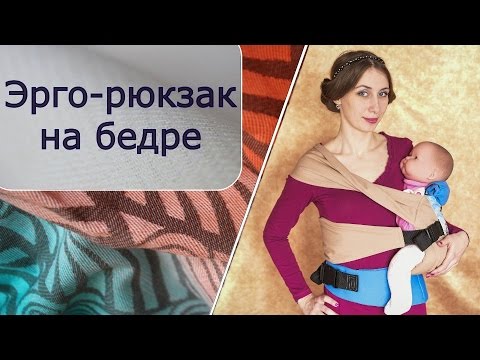
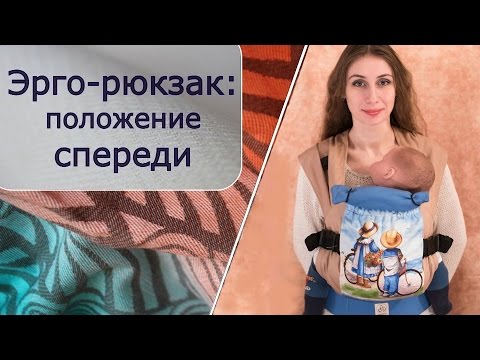
Another miracle phrase from the “advisers”: “When you are 4 months old, you can wear it in an ergo.”
This is not true. So, you, mothers, let’s say at 25 years old, all of the same height, size, weight and physical fitness? No. Why then should we imply that all our children, as soon as they turn 4 months old, become the same size, suitable for any ergo, and all together on the same day become one step in their development? WE ARE ALL DIFFERENT. AND BABIES ARE ALL DIFFERENT TOO. And this is good! Therefore, focus not on ephemeral age limits, but on skills and development his child.
What does it say about this Unified instructions Slingoligs?
I quote: “It is allowed to wear in ergonomic backpack from the age when the child confidently holds his head and, when lying on his stomach, can rise with support on his forearms. As a rule, this is 4 months of age. At this age, belly-to-belly carrying is acceptable.”
I decipher: If your child already has the skills described above and you We selected an ergo-backpack that fits him perfectly in size, and for some personal reasons you do not want or cannot carry your child in options that are more suitable for his age - a sling with rings, a sling-scarf, a May-sling, you may well start using an ergonomic backpack. Again. IF YOU HAVE CHOOSE A BACKPACK THAT IS SUITABLE IN SIZE FOR YOUR CHILD. In the case of backpacks with a back that is not adjustable in width and height - read on, try it on, because... if it is not regulated, then you will not be able to determine this moment in absentia.
Understand - you can carry in an ergonomic backpack even from birth. Only such a backpack should then be sewn according to the individual measurements of your newborn, taking into account his measurements at the moment. You can order such a backpack and the child will be in a wonderful and safe position. In about a month, this backpack will be too small for the child.
Think about it: the manufacturer indicates the age range for its backpacks - 4 months - 2 years. At the same time, the backrest is NOT ADJUSTABLE in width or height. Here's how, by what miracle, this backpack will equally fit your child at 4, 6 months, or a year? Yes, in some one or two months from this time period (we can’t know which one, because all children are different), this backpack will be just right for your baby, that’s for sure. What about the rest of the time?
Why such restrictions? Because the ergo-backpack, of all the physiologically safe types of carriers, is the least adaptable to the child. When your child already knows how to sit, his spine is developed and strengthened so much that by picking up a backpack that is not particularly suitable in size and somehow stuffing the child into it, you won’t be able to do much harm.
An ergonomic backpack is a wonderful carry. Convenient, easy to learn, load-bearing. But she ALSO NEEDS TO BE ABLE TO USE A SLING. Be able to sag your butt, round your back, spread your legs to a comfortable angle, and not “widely, so that the child hugs you with his legs.” Select a backpack that is suitable for the child in size, preferably with an adjustable back, if the back is not adjustable, it is VERY ADVISIBLE to measure before buying.
Remember that the seller who writes that this non-adjustable backpack can be worn from exactly 4 months does not bear any responsibility for the health of your child, he just wants to sell more of his backpacks. If you place your child in a backpack incorrectly, again, no one except you is responsible for possible problems in the future.
Some of those reading this will probably say or think, “But I wore mine like this, and nothing happened, a healthy child.” I'm glad you're lucky. This does not happen for everyone; there are cases when children had problems, for example with the hip joint, due to a negligent attitude to this issue.
To do something right, you need to learn. To wear it correctly in an ergo, you need to learn. Learning to wear it will take a very small part of your precious time and most likely will not cost you anything. I think you'll agree that your own child is worth this little effort.
And finally, a photo of what it should look like, good luck everyone, I'm off to bed
